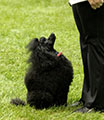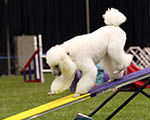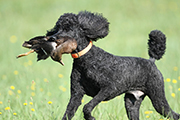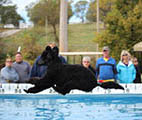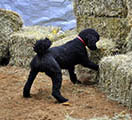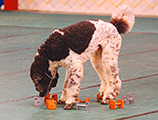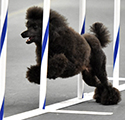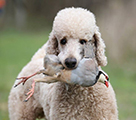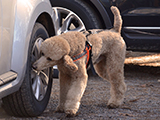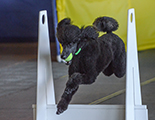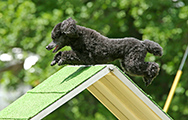Poodle Ear Care
Disclaimer: This information is provided by Versatility in Poodles (VIP) for informational purposes only. It is assumed that you are working with your veterinarian on the medical care of your dog. Some home remedies for ear problems, which are used successfully by many Poodle owners, are given below.
Anatomy
The Poodle ear canal is deep, dark, and moist. Frequently the hair in the canal grows similarly to the thickness and speed of that on the body. At the bottom of the canal is the ear drum, and great care must be taken not to damage the drum. The ear canal glands make wax to protect the delicate tissues. This dark, warm, and moist environment is a great place for yeast and bacterial infections, mites, ticks, and grass awns (seeds) such as foxtails to accumulate.
Weekly Examine
Check the ear every week. You want to verify that the ear smells sweet with no bad odors. The ear should appear clean with no dark spots, dirt, or debris in the ear. An infection or a foreign body in the ear is suspected if your dog has brown material in the ear, shakes its head regularly, or cries when the head is shaken. You may need veterinary help to get the problem under control. By the same token, if it isn’t “broke,” then don’t fix it; in other words, if what you are doing for your dog is working, don’t change what you are doing. You may need to experiment to find what works best for you and your dog.
Plucking
Some dogs seem to have very little ear canal hair, while others seem to have a lot. Plucking of ear hair is a matter of preference. There are people who don’t pluck ear hair and people who do, and both can be quite passionate that “their way” is the best way. You may not want to pluck ear hair at all unless there is a lot of it. You may choose to pluck just a little in order to thin it out, or you can pluck until every hair is gone. If you are not currently showing your Poodle in conformation, another option to open up the ear to allow for better air flow may be to simply trim all excess hair from the inside ear leather, or even the outside leather. You can also trim the hair inside the canal very carefully.
If you choose to pluck the ear hair use a well-lighted area. Place the dog on its side on a grooming table and carefully pull out the hair with a hemostat. These instruments can be obtained from most grooming supply services. Using a bit of ear powder will assist in being able to grasp the hair effectively. Be careful not to pinch the skin in the ear canal with the hemostat. If the dog has a significant amount of hair, pull out a small portion of the hair in several sessions over the period of a week, skipping a day or two between sessions. Heavy pulling of hair in a single session can cause inflammation of the ear canal. This creates an ideal environment for bacterial or fungal growth.
Washing the Ear
The dog’s ears should be washed every time the dog is bathed. The objective is to wash away any debris from the ear. There are many preparations available for washing the ears. These include your dog’s full strength shampoo or a commercial ear wash from a vet supply house. Some people prefer to use rubbing alcohol, but it can be quite irritating to a sensitive ear canal especially if not diluted with water and/or vinegar.
Regardless of the solution used, massage a small amount into the dog’s ear canal. After a few seconds, rinse the ear canal with a gentle stream of warm water. The Poodle will shake its head as soon as you allow. A cotton ball may be used to gently blot any excess water.
When you dry the dog, open the ear back and gently allow some of the air from the dryer to flow across the ear as you dry the hair on the inside of the ear leather. You want to make sure that you get the inside of the ear canal completely dry.
When cleaning your dog’s ears, remember to never insert anything into your dog’s ear canal such as Q-tips. Hemostats are commonly used to remove hair and cotton balls may be used to remove moisture. If you notice something in the ear that doesn’t wash out, please have your vet examine the dog’s ears. Don’t try to remove any foreign object yourself.
If your dog loves the water, make sure that you clean the ears and put a drying agent into them after every swimming session. If your dog had long or thick ear hair, you must be sure that the ear hair is also dry before applying a drying agent into the ear canal.
Treatment with a Drying Agent
An ear treatment may be used weekly to monthly. One home remedy recipe is 1/3 part white vinegar, 1/3 part rubbing alcohol, and 1/3 part water. Other home remedy recipes are included at the end of this article for “Purple Ear Wash” and “Dry Ear Powder.” All of these products work similarly. Vinegar lowers the pH so that most bacteria and fungus can’t grow. Alcohol kills germs and dries the canal, and water provides dilution so that the vinegar and alcohol are not too strong for the tissues. The Gentian Violet in “Purple Ear Wash” also kills fungus.
Treatment of Infections
If the Poodle has wet, damp, smelly ears or has gunk in the ears, it may be an indication of a mild infection. It may be treated by using one of the treatment recipes twice daily for two weeks, then once daily for an additional two weeks, then once a week for an additional month. Weekly to monthly treatments as listed above should keep the ear healthy after that.
If the problem is not resolving quickly, or gets worse, you will need to make an appointment with your veterinarian. If your dog has pus in the ear, don’t delay. You should immediately seek veterinary help and not use any home remedy in the ear. A culture must be taken to be sure that any prescribed antibiotic is the correct one for that particular infection. Many antibiotics, including most of the “mycins” can damage the hearing of your dog. Some topical drugs often induce allergies. Be sure to discuss these issues with your veterinarian when deciding on a course of treatment.
Warning: A severe infection may result in ear drum perforation. NEVER put a cleanser or medications in an ear that may have an open ear drum without first consulting your veterinarian. Many agents that are safe to use in an inflamed canal can be VERY dangerous if put into the middle ear and deafness or worse can result. If you have any doubt whether the drum is intact, do nothing until you consult with a vet.
For the serious chronic ear infection it may be necessary to put the dog on a rigorous program of twice a day cleansing with TRIS-EDTA solution mixed with an antibiotic such as Baytril, plus a systemic antibiotic for as long as six weeks. Your veterinarian may recommend a short course of topical steroid drops to reduce the inflammation and swelling so that the dog will be more comfortable until the infection gets under control. “Baytril otic,” a combination of antibiotic (enrofloxacin) and silver sulfadiazine, is another good topical ear drop.
Fungal Infections
Fungus thrives in dark and damp conditions. Because the ear canal is dark and damp, some dogs may develop a chronic fungal infection. A fungal infection should NOT be treated with steroids, as it will make the infection worse. When a veterinarian treats an allergic dermatitis with steroids, it usually results in an overgrowth of fungus in the ear. The treatment for a fungal infection is keeping the ear very dry and perhaps administering a topical fungal medication. Usually keeping the ear DRY and acidic (a dilute solution of white vinegar is good for this) will clear up a fungal infection.
Allergies
If you continue to have ear problems, consider the possibility of food allergies. Grain-free diets or changing the protein source can do wonders to clear up ear problems in Poodles.
Some dogs have multiple skin allergies, allergic diarrhea, flea allergies, and some even have frequent sneezing and scratching. This type of dog frequently also has a chronic ear problem. The ear leathers may be red and itchy. There may even be hives on the ears. If this is the case you need to find what your dog is allergic to—be it an environmental problem, or a food, the type of shampoo you are using on the dog, or a flea product. You may need the help of a veterinary dermatologist. As long as your dog has a topical allergy problem, you may not be able to clear up the irritated ear problem.
Purple Ear Wash
The recipe makes a huge batch. You can divide the amounts by 4.
16 oz. bottle isopropyl alcohol
4 tablespoons boric acid powder
16 drops gentian violet 1% solution
Shake solution well before each use. Use a dropper to fill the ear canal with solution. Put a cotton ball in the ear, leaving it at the edge of the ear, not pushed deeply in, while massaging the base of the ear for about 30 seconds. Keep blotting gently with cotton balls until the solution is absorbed. The first time you use this you may want to reload the ear with the solution a couple of times to really flush the ear out.
Follow this procedure twice a day for two weeks, then once a day for an additional two weeks, then once monthly for maintenance.
The dog will shake the excess out. Be careful as the gentian violet will stain whatever it comes in contact with, including your hands and the dog’s hair. You may want to do it outside.
If you are concerned about the alcohol burning the inside of the ear, which is possible if the dog has been scratching its ear, you can substitute witch hazel for the alcohol.
All ingredients are available at a pharmacy. The boric acid is usually in the first aid section with the alcohol. The gentian violet will be the hardest to find and may need to be special ordered.
Despite the alcohol, dogs don’t object to even the first treatment. The boric acid soothes the ear and the gentian violet is an anti-infection agent. This solution is also effective for the treatment of fungal type infections on the dog including hot spots.
Avoid getting this solution in the eyes.
Dry Ear Powder
4 oz. zinc oxide powder
4 oz. boric acid powder
1/2 oz. iodoform powder
Mix well. Keep in a sealed jar in a cool dry place.
Maintenance use: Place a large pinch of powder in each ear, and use your finger to work it down into the ear canal. Wait five or ten minutes then pluck the hair out of the ears. Allow the dog to shake, but leave the excess powder in the ears. Repeat monthly.
All dry preparations incur the risk of making ‘cement’ in the ear if there is a moist discharge. Be very careful to avoid this situation by using such agents very sparingly. If you have a moist discharge, then you need to go back to the instructions on mild infections above and use the “Purple Ear Wash” or alcohol/vinegar/water solution.
This powder is available for purchase from Gayle Roberson under the name DRY IT UP EAR POWDER. Her website is: http://www.pocoapocopoodles.com/products.html.
Dry Ear Powder is also available from:
Ron’s Apothecary Shop
117 West Renfro
Burleson, Texas 76038
817-295-2273
Ask for Ron; he is knowledgeable about orders for this product.
Disclaimer: Use at your own discretion and at your own risk.
The information contained in these documents is current at the time of this writing and is accurate to the best of VIP’s knowledge.
This information has been provided to you at no charge. You are free to use it provided it is used in its entirety with no changes or alterations and that the copyright remains intact. If you have found this information to be helpful, please consider making a tax-deductible donation to:
Versatility in Poodles
4061 Highlands Rd
Franklin, NC 28734
To make a donation via PayPal, please click the Donate Button:
The contents of the www.vipoodle.org website, such as text, graphics, images, and other material contained on this site (“Content”) are for informational purposes only. The Content is not intended to be a substitute for professional veterinarian advice, diagnosis, or treatment. Always seek the advice of your veterinarian with any questions you may have regarding the medical condition of your pet. Never disregard professional advice or delay in seeking it because of something you have read on this website!
If you think your pet has a medical emergency, call or visit your veterinarian or your local veterinary emergency hospital immediately. Versatility in Poodles and www.vipoodle.org do not recommend or endorse any specific veterinarians, products, procedures, opinions, or other information that may be mentioned on this website. Reliance on any information appearing on this website is entirely at your own risk.


